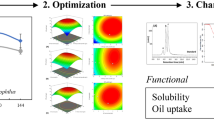Abstract
A new kind of extracellular polysaccharide (EPS) from Pseudomonas fluorescens PGM37 was obtained and culture media was optimized using the statistical methods single factor experiments and response surface methodology (RSM) design. As a result, the optimum cultivation conditions initial pH value, medium volume, inoculum size, temperature, and rotation speed were 7.5, 100 mL/250 mL, 5 %, 28 °C, and 180 rpm, respectively. The optimized media: sucrose 36.23 g L−1, yeast extract 3.32 g L−1, sodium chloride 1.13 g L−1, and calcium chloride 0.20 g L−1. The maximum predicted yield of EPS was 10.1163 g L−1 under these conditions. The validation data was 10.012 g L−1, which could strongly confirm the correlation between the experimental and theoretical values. Gas Chromatography analysis revealed that the polymer was made up of mannose and glucose in the ratio of 1:1. Infrared spectroscopy showed that the polysaccharide had β-D-pyranoid configuration and contained no other substituent. Graded by different multiples of alcohol after specific degradation by enzyme and then detected by LC-ESI-MS, the EPS structure was β-D-Glcp-(1, 4)-β-D-Manp-(1, 4)-β-D-Glcp-(1, 4)-β-D-Manp. The moisture retention ability of the EPS was found to be superior to glycerol and only a little inferior to hyaluronic acid (HA), which presented potential application value in cosmetics and clinical medicine fields.








Similar content being viewed by others
References
Adinarayana K, Ellaiah P, Srinivasulu B, Bhavani Devi R, Adinarayana G (2003) Response surface methodological approach to optimize the nutritional parameters for neomycin production by Streptomyces marinensis under solid-state fermentation. Process Biochem 38(11):1565–1572
Chen QH, Li WQ, Zhang SJ, Chen ZF, Peng HP, Zheng SW (2003a) Analysis of polysaccharide composition of marine microalgae by gas chromatography. J Xiamen Univ 42(4):495–498
Chen LY, Du YM, Zeng XQ (2003b) Relationships between the molecular structure and moisture-absorption and moisture-retention abilities of carboxymethyl chitosan. Carbohydr Res 338(4):333–340
Chong BF, Blank LM, Mclaaughlin R, Nielsen LK (2005) Microbial hyaluronic acid production. Appl Microbiol Biotechnol 66(4):341–351
Dubois M, Gilles KA, Hamilton JK, Rebers PA, Smith F (1956) Colorimetric method for the determination of sugars and related substances. Anal Chem 28(3):350–356
Frey DD, Engelhardt F, Greitzer EM (2003) A role for “one-factor-at-a-time” experimentation in parameter design. Res Eng Des 14(2):65–74
Guo ZC (2005) Carbohydrate chemistry. Chemical Industry Press, Beijing
Kumar AS, Mody K, Jha B (2007) Bacterial exopolysaccharides—a perception. J Basic Microb 47(2):103–117
Lee H, Song M, Hwang S (2003) Optimizing bioconversion of deproteinated cheese whey to mycelia of Ganoderma lucidum. Process Biochem 38(12):1685–1693
Li C, Bai J, Cai Z, Ouyang F (2002) Optimization of a cultural medium for bacteriocin production by Lactococcus lactis using response surface methodology. J Biotechnol 93(1):27–34
Li HF, Xu J, Liu YM, Ai SB, Qin F, Li ZW, Zhang HR, Huang ZB (2011a) Antioxidant and moisture-retention activities of the polysaccharide from Nostoc commune. Carbohydr Polym 83(4):1821–1827
Li LY, Jiang XL, Guan HS, Wang P, Guo H (2011b) Three alginate lyases from marine bacterium Pseudomonas fluorescens HZJ216: purification and characterization. Appl Biochem Biotechnol 164(3):305–317
Liu GC (2012) Chemical compositions, α-glucosidase and α-amylase inhibitory activities of crude polysaccharides from endodermis of shaddock (Citrus maxima). Arch Biol Sci Belgrade 64(1):71–76
Liu L, Sun J, Zhang DX, Du GC, Chen J, Xu WB (2009) Culture conditions optimization of hyaluronic acid production by Streptococcus zooepidemicus based on radial basis function neural network and quantum-behaved particle swarm optimization algorithm. Enzyme Microb Technol 44(1):24–32
Luce G, Myoupo JF, Yoshida S, Oka H, Moreno J, Vargas MA, Olivares H, Rivas J, Guerrero MG (1998) Exopolysaccharide production by the cyanobacterium Anabaena sp. ATCC 33047 in batch and continuous culture. J Biotechnol 60(3):175–182
Oh S, Rheem S, Sim J, Kim S, Back Y (1995) Optimizing conditions for the growth of Lactobacillus casei YIT 9018 in tryptone-glucose medium by using response surface methodology. Appl Environ Microb 61(11):3809–3814
Osborn HMI, Lochey F, Mosley L, Read D (1999) Analysis of polysaccharides and monosaccharides in the root mucilage of maize (Zea mays L.) by gas chromatography. J Chromatogr A 831(2):267–276
Patil KP, Kamalja KK, Chaudhari BL (2011) Optimization of medium components for hyaluronic acid production by Streptococcus zooepidemicus MTCC 3523 using a statistical approach. Carbohydr Polym 86(4):1573–1577
Pujari V, Chandra TS (2000) Statistical optimization of medium components for enhanced riboflavin production by a UV-mutant of Eremothecium ashbyii. Process Biochem 36(1):31–37
Raza W, Yang W, Jun Y, Shakoor F, Huang QW, Shen QR (2012) Optimization and characterization of a polysaccharide produced by Pseudomonas fluorescens WR-1 and its antioxidant activity. Carbohydr Polym 90(2):921–929
Sheng GP, Yu HQ, Li XY (2010) Extracellular polymeric substances (EPS) of microbial aggregates in biological wastewater treatment systems. Biotechnol Adv 28(6):882–894
Sun LP, Du YM, Yang JH, Shi XW, Li J, Wang XH, Kennedy JF (2006) Conversion of crystal structure of the chitin to facilitate preparation of a 6-carboxychitin with moisture absorption–retention abilities. Carbohydr Polym 66(2):168–175
Yan H, Cai B, Cheng Y, Guo GN, Li D, Yao XL, Ni XW, Phillips GO, Fang YP, Jiang FT (2012) Mechanism of lowering water activity of konjac glucomannan and its derivatives. Food Hydrocolloid 26(2):383–388
Yang SL, Guo ZY, Zhou YL, Zhou LL, Xue QZ, Miao FP, Qin S (2010) Synthesis and moisture absorption and retention activities of a carboxymethyl and a quaternary ammonium derivative of α, α-trehalose. Carbohydr Res 345(1):120–123
Zhang WJ (1999) Biochemical research techniques of glycoconjugates. Zhejiang University Press, Hangzhou
Acknowledgments
This work was supported by the Ocean Public Welfare Scientific Research Project, State Oceanic Administration People’s Republic of China (No. 201105028-4), and the Natural Science Foundation of China (No. 30901122).
Author information
Authors and Affiliations
Corresponding author
Rights and permissions
About this article
Cite this article
Zhao, L., Fan, F., Wang, P. et al. Culture medium optimization of a new bacterial extracellular polysaccharide with excellent moisture retention activity. Appl Microbiol Biotechnol 97, 2841–2850 (2013). https://doi.org/10.1007/s00253-012-4515-0
Received:
Revised:
Accepted:
Published:
Issue Date:
DOI: https://doi.org/10.1007/s00253-012-4515-0




